High Current Ion Sources
PIG (Penning Ionization Gauge) ion source
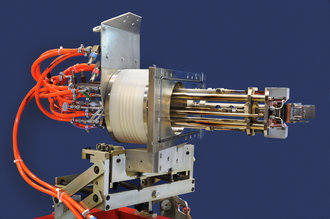
The PIG source has a long tradition at GSI. This type of ion source has been used since the beginning of GSI operation in the early 1970ies. The ion source is installed in high voltage Terminal South in order to inject multiply-charged ions with ion beam currents of several hundreds of electrical microamperes into the high current injector (HSI) of the UNILAC. Gaseous (argon, neon, krypton, xenon…) as well as metallic ions (aluminum, bismuth, chrome, gold, lead…) are produced and post-accelerated to the injection energy of the radio-frequency quadrupole of 2.2keV/u. The speciality of this ion source is the plasma generation inside a strong magnetic dipole field.
Maximum A/Z | 65 |
Extraction voltage | up to 22 kV |
Post-acceleration | up to 135 kV |
Duty cycle | up to 50 Hz / 5 ms |
Main elements | Ne, Ar, Ca, Ti, Ni, Kr, Xe, Mo, Sm, Au |
MUCIS (MUlti Cusp Ion Source)
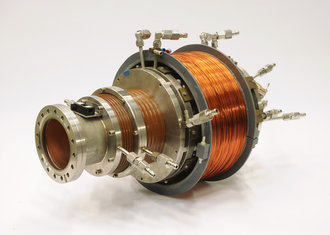
MUCIS is one of the first high current gaseous ion sources used at GSI for beamtime operation. It is a filament driven ion source with non-axial filament configuration. It has two filament holders which are equipped with 3 spiral tantalum filaments and placed symmetrically relatively to the beam axis. The multi-cusp field is realized by 60 SmCo-magnets (1.8 Tesla). In addition one can apply a confining field of up to 0.1 Tesla with an external magnetic coil. MUCIS is universal source for production of all types of gaseous ions (light and heavy gases).
Plasma generator | Dimensions: ø 205 x 215 mm |
Multi-cusp magnetic confinement | |
Electron repeller | |
2 x 3 Ta-filaments | |
Extraction system | Triode, Multi aperture: 13 x ø 3 mm |
Aspect ratio: 0.5 | |
Extraction voltage: up to 33 kV | |
Post-acceleration: up to 150 kV | |
Operation parameters | Arc current: up to 200 A |
Emission current density: up to 180 mA/cm2 | |
Typical duty cycle: 5 Hz, 1 ms | |
Working gas | H2, D2, He, CH4, Ne, N2, Ar, Kr, Xe |
History | In operation at GSI: since 1987 |
Developer: GSI, H. Wituschek |
MUCIS New (MUlti Cusp Ion Source) 2010
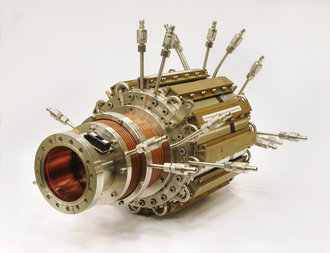
MUCIS New is a new generation filament driven ion source designed for production of highly charged gaseous ions (for work with heavy gases such as Kr and Xe). It has a bigger plasma chamber and better cooling compared to MUCIS that allows to operate with higher discharge currents and to achieve a higher mean charge-state of ions in the plasma. A single filament holder is placed on the beam axis and can be equipped with two tungsten filaments. The confining multi-cusp field is realized by 60 SmCo-magnets (1.8 Tesla) aligned in Halbach geometry (additional protection of magnets against plasma losses). Symmetrical magnet alignment at both ends of the plasma chamber provides magnetic electron repelling.
Plasma generator | Dimensions: ø 250 x 255 mm |
Multi-cusp magnetic confinement | |
Electron repeller | |
2 x 3 W-filaments | |
Extraction system | Triode, Multi aperture: 13 x ø 3 mm |
Aspect ratio: 0.5 | |
Extraction voltage: up to 33 kV | |
Post-acceleration: up to 150 kV | |
Operation parameters | Arc current: up to 400 A |
Emission current density: up to 180 mA/cm2 | |
Typical duty cycle: 5 Hz, 1 ms | |
Working gas | H2, D2, He, CH4, Ne, N2, Ar, Kr, Xe |
History | In operation at GSI: since 2009 |
Developer: GSI, R. Hollinger, F. Heymach |
CHORDIS (Cold or HOt Reflex Discharge Ion Source)
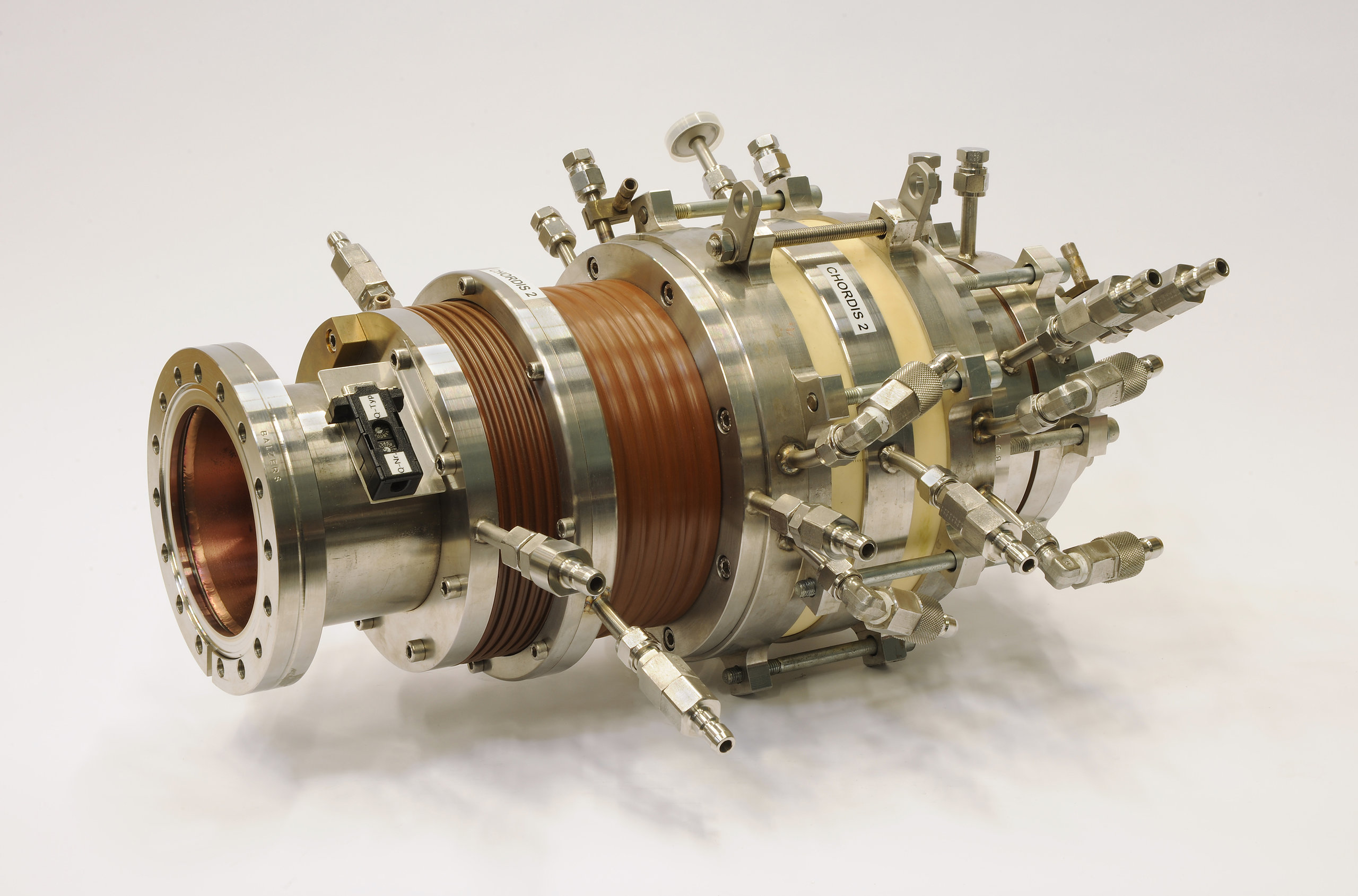
CHORDIS is a filament driven ion source with a small plasma chamber designed for production of singly-charged ions. It has a single filament holder placed on the beam axis (in the middle of the plasma chamber) and is equipped with 6 spiral filaments made of tungsten or tantalum. The confining multi-cusp field is realized by 20 SmCo-magnets (1.8 Tesla). The specificity of CHORDIS source is the electrostatic electron repeller (reflector electrode) and the negatively biased plasma electrode.
Plasma generator | Dimensions: ø 90 x 80 mm |
Multi-cusp magnetic confinement | |
Magnetic electron repeller | |
6 x W-filaments | |
Extraction system | Triode, Multi aperture: 13 x ø 3 mm |
Aspect ratio: 0.5 | |
Extraction voltage: up to 33 kV | |
Post-acceleration: up to 150 kV | |
Operation parameters | Arc current: up to 400 A |
Emission current density: up to 180 mA/cm2 | |
Typical duty cycle: 5 Hz, 1 ms | |
Maximum duty factor: 100% | |
Working gas | H2, D2, CH4, N2, O2, Ne, Ar, Kr, Xe |
History | In operation at GSI: since 1984 |
Developer: GSI, R. Keller |
MEVVA (MEtal Vapor Vacuum Arc Ion Source)
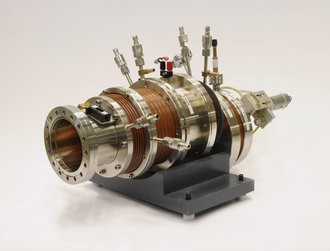
MEVVA is one of the first ion sources in the world based on vacuum arc plasma production principle. It was developed by I.G. Brown in Berkeley National Laboratory (LBNL, USA) and came to GSI in 1995. Since that time the MEVVA ion source was upgraded and optimized for longer and more stable operation.
The cathode flange of the ion source has a revolver design and is equipped with 17 cathodes. The ion source comprises two magnetic coils 0.1 and 0.2 Tesla respectively. They are used to confine the plasma in the discharge region in order to control the charge-state distribution of ions as well as focus the plasma in the drift region.
The MEVVA ion source works with all types of ductile conductive metals. The typical lifetime of MEVVA is 1 week in synchrotron operation mode.
Plasma generator | Dimensions: ø 40 x 110 mm |
Extraction system | Triode, Multi aperture: 13 x ø 3 mm |
Aspect ratio: 0.5 | |
Extraction voltage: up to 33 kV | |
Post-acceleration: up to 150 kV | |
Operation parameters | Arc current: up to 2000 A |
Emission current density: up to 170 mA/cm2 | |
Typical duty cycle: 1 Hz, 1 ms | |
Working elements | O2, Mg, Ca, Ti, Ni, Mo, Ag, Nd, Ta |
History | In operation at GSI: since 1999 |
Developer: LBNL (USA), I.G. Brown |
VARIS (Vacuum ARc Ion Source)
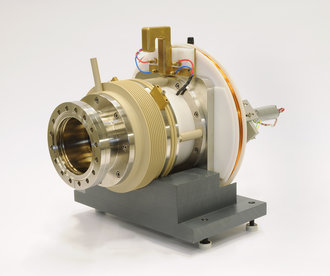
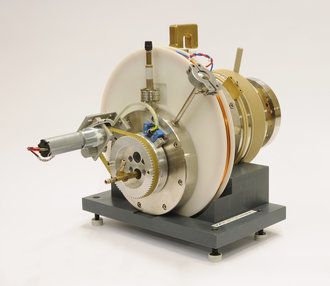
VARIS is a new generation of vacuum arc-type ion source. It was developed at GSI as a redesign of MEVVA and commissioned in 2004. VARIS is optimized for production of highly charged ions (up to 6-fold) and therefore it is foreseen for operation with heavy elements. It provides the best charge-state distribution for uranium ions (67% of 238U4+).
Compared to MEVVA ion source, VARIS has a smaller plasma chamber, shorter distance between anode and cathode and a more compact drift region to the extraction system. In contrast to MEVVA ion source, VARIS is equipped with two magnetic coils outside the plasma chamber for focusing and transporting the plasma. The cathode flange has a revolver system and is equipped with 17 cathodes, too. The specificity of VARIS is the absence of water cooling and a compact design.
The typical lifetime of one uranium cathode is about 8 hours and of the source is about 1 week.
Plasma generator | Dimensions: ø 65 x 80 mm |
Extraction system | Triode, Multi aperture: 13 x ø 3 mm |
Aspect ratio: 0.5 | |
Extraction voltage: up to 40 kV | |
Post-acceleration: up to 150 kV | |
Operation parameters | Arc current: up to 2000 A |
Emission current density: up to 300 mA/cm2 | |
Typical duty cycle: 1 Hz, 0.5 ms | |
Working elements | O2, Mg, Ca, Ti, Ni, Mo, Ag, Nd, Ta, Au, Pb, Bi, U |
History | In operation at GSI: since 2004 |
Developer: GSI, R. Hollinger |
High charge state ion sources
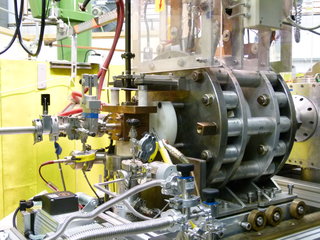
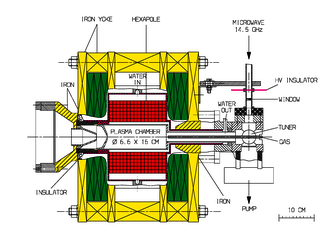
ECRIS CAPRICE 1.0 T
The 1.0 T CAPRICE-type ECR ion source is delivering beam starting in 1992 to the High Charge State Injector (HLI) of the GSI accelerator facility.
Utilizing the electron cyclotron resonance effect for efficient plasma generation this ion source can provide high charge-state ion beams for almost the whole range of elements (from hydrogen to lead).
The constant and stable ion beam and the very low material consumption are the major advantages of this type of ion source which is very favorable for efficient long time operation at the accelerator.
ECRIS CAPRICE 1.2 T
Higher plasma densities are the precondition for the extraction of higher currents of ion beams. In order to reach higher densities the confining radial magnetic field has been increased to 1.2 T. This version of ECRIS was installed at the ECR injector setup for ion beam development and beam transport optimization until 2013. Since the beginning of 2014 this upgraded version is available at the HLI for routine operation.
Magnetic confinement | Hexapole field | 1,0 - 1,2 T |
Solenoid field | 0,8 - 1,5 T | |
Microwave system | Microwave-frequency | 8 - 18 GHz |
Microwave-power | 50 - 800 W (cw mode) | |
plasma generator | Gas pressure | 10-6 - 10-4 mbar |
Gas consumption (typical) | 1 scm3/h | |
Current density (typical) | 1 mA/cm2 | |
Electron energies | up to several 100 keV | |
Extraction system | Triode - accel-decel, single aperture | plasma electrode 10 mm |
Extraction voltage | 5 - 22 kV | |
some typical elements | C, O, Ne, Ar, Kr, Xe | Li, Mg, Ca, Ni, Zn, Sn, Au, Pb |



